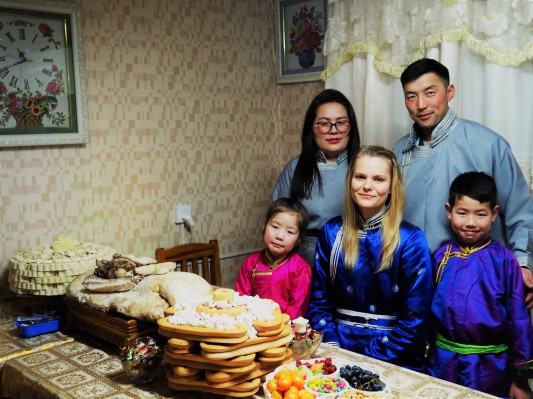TRAVEL SOLO
As someone who dislikes sweat and heat and would rather hibernate during the hot summer months in a cold room, my two-week solo trip to Vietnam and Cambodia went remarkably well despite my 21 hours in layovers. I was anxious about going by myself. Previously, I had only traveled to Norway and Iceland by myself. But now I would be traveling throughout Southeast Asia. Fortunately, I met many solo travelers. I had all my papers to show in the airports for my visas. I didn’t lose anything. I didn’t get lost with my terrible sense of direction and I became a master at retracing my steps and map reading because I’m ridiculous and have no data on my phone.
I had 7 vacation goals:
- Eat as much food as possible. After a year in Mongolia, this was a priority.
- Go shopping.
- Go to a spa.
- Get tan.
- Avoid heat stroke.
- Don’t lose my passport.
- Don’t get kidnapped.
All goals were achieved except #4. Though if anyone wants to lie and say I look tan, I would appreciate that.

VIETNAM
After a seven-hour layover in Seoul, I landed in Hanoi, Vietnam where I was instantly enveloped by a hot blanket of heat. A person from the hostel met me at the arrivals gate holding a sign. I gave them Anna Sofia to avoid any mistakes with my last name and the sign said, “Anna So Jia.” I stayed at Vietnam Backpackers Hostel Original, a hostel I would recommend. The hostel provides a free city tour in addition to other tours, free breakfast until 10, and free beer at 18:00.
If I could describe Hanoi, I would say fast, steamy, vibrant, and chaotic. My hostel including every restaurant, store, and market I walked into had fans blowing at high speeds to combat the heat but the heat still had a way of creeping in and clinging to you. Buildings are tall and very narrow but stretch back far while markets are crammed underneath where Vietnamese people are sitting upon their stools inside and out on the pavement. The smell of street food permeates the air. Everywhere on the streets were families grilling various foods and preparing soups with fruit stands and baskets interweaving between. The streets are chaotic but an organized chaos as motorcycles and mopeds outnumber cars. Despite it, I felt strangely calm. I tried an egg coffee which I wouldn’t have again. It was very sweet. I ate a lot of seafood, pineapple, and mango.

During the week, I went on a free city tour. It was on this tour that I met a small group of Canadian med students who adopted me into their group. I also met a Danish girl who everyone thought was my sister.

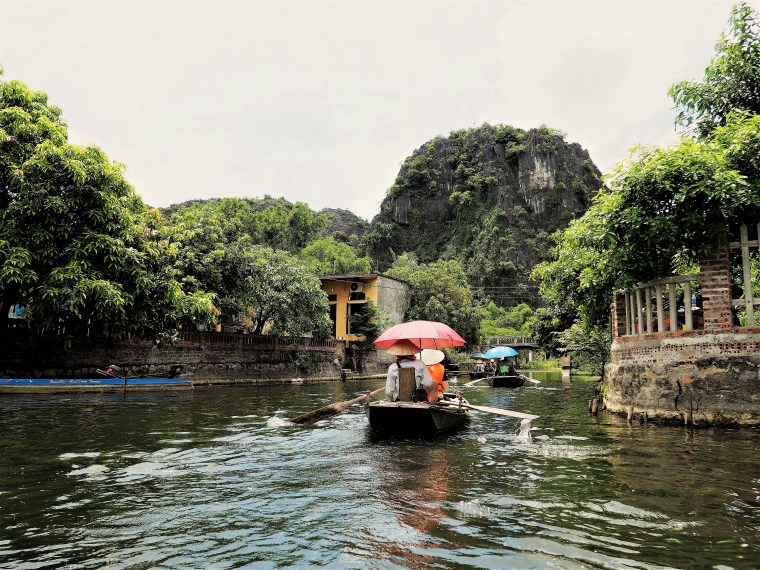
One day, I took a bus to Vietnam’s old capitol, Hoa Lu, in Ninh Binh Province. Now it is just monasteries. After walking around, I switched over to a bamboo boat. The rowers rowed with their feet while holding umbrellas and fans in their hands. We were rowed past hills that sprouted from the water and through caves when the hills connected. White goats dotted the sheer cliff sides as they munched on the tufts of grass. I also rode a bike throughout the countryside as it poured down with rain.

HA LONG BAY
Ha Long Bay is beautiful! The weather was perfect and the water was so blue. I went through Lily’s Travel Agency, an agency that provided a one-day tour of the bay at a cheap price. They also do three-day tours. I almost missed this trip because I slept past my alarm and woke up at 7:30 for an 8:00 departure. It was a four-hour drive to Ha Long Bay, also known as Bay of Descending Dragons. On the boat we sailed on, I met students from the University of Bristol where I studied abroad and an Australian mother and daughter. Since I was by myself and the three boys were hilariously stupid, the Australian mother, Karin, took us in as her new silly family during the trip.


Our boat provided us with a seafood lunch and we explored a cave called Thien Cung Grotto where our guide, Lhong, began to mess with us by pointing out animal-shaped rocks that only he could see. “What is that rock?” “I see a rock.” “No, it’s a wolf.”
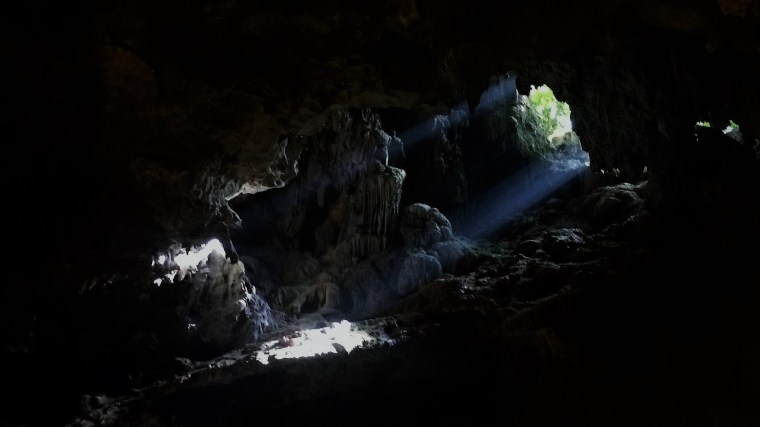
Note: Americans need an invitation letter to enter. I got mine for $5 from Lily’s Travel Agency. Other places, such as my hostel, charge $25 for the letter.
CAMBODIA
Vietnam and Cambodia share a border. Despite proximity, I had to fly Hanoi – Bangkok – Phnom Pehn. I spent seven-hours in Bangkok for a flight to Cambodia that was only 50 minutes. I found a comfortable couch in an empty terminal next to a Dairy Queen where I sat reading Hello magazines. I arrived in Phnom Penh at 22:00 and took a tuk tuk to Onderz Hostel. A tuk tuk is my new favorite mode of transportation. Very cheap. A tuk tuk is also the best way to stay cool because of the wind.

Note: Tuk tuk drivers are extremely persistent. After talking to one, he said that there are too many tuk tuk drivers thus making the job very competitive. When coming out of a restaurant, me and another girl said we were going into a store. As I was sitting on a couch, I saw the tuk tuk driver peering at me through the store window waiting for us.
My hostel is next to the Royal Palace, the Night Market, and the river. Phnom Penh had trash littered on the roads causing a terrible smell while riding in a tuk tuk and the nice homes secluded themselves behind high walls and gates. There is a large mall called Aeon Mall where I found delicious $5 sashimi and a Starbucks.
CAMBODIAN HISTORY
Cambodia has a gloomy and mournful history and too many people remain unaware of this. From 1975 to 1978, the Cambodian Civil War ravaged the country and killed over a million Cambodians constituting as genocide. Phnom Penh is home to the Genocide Museum and Choeung Ek. Choeung Ek is the most well-known of over 30 killing fields in Cambodia. Bones and teeth continue being unearthed from mass graves especially during the rainy season. At Choeung Ek, the Khmer Rouge played loud, festive-sounding Cambodian music to drown out the sounds of the murdered. In the center of the killing field is a memorial stupa with hundreds of skulls of dead Cambodians. The skulls at the bottom had colored dots to indicate how the person died. It was either by a machete, a hoe, bamboo sticks, wooden sticks, and anything else that was at hand and convenient for butchering fellow Cambodians. The Khmer Rouge were running out of bullets and didn’t have enough money to buy more. Thus, the brutal way of killing. Read here for more about the Civil War. Even after the war, the western world still acknowledged the Khmer Rouge as Cambodia’s legitimate government and the response against war criminals took to long.

Tuol Sleng Genocide Museum was first a school that became a building for torture and killing. Blood stains are still darkly visible on the floors next to the torture beds, the only piece of furniture in the rooms. The cells were small and narrow and made entirely of brick. When prisoners arrived, their mugshots were taken. Now, all the pictures are up on display for visitors to gaze into the sorrowful eyes of men and women, young and old, who knew they were going to die. Some women were still holding their babies as their pictures was taken. It was awful.

SIEM REAP
A bus ride to Siem Reap is approximately five hours. I rode Grand Ibis, a comfortable bus with lots of leg space, air conditioning, and Wi-Fi. On the bus, I met an Australian couple who I ate lunch with. Farther away from the city, houses are held up on high stilts to elevate when the monsoon comes. I stayed at Pool Party Hostel in Siem Reap. The hostel offers free tuk tuk drives to Pub Street every day except Sundays. Pub Street has heaps of restaurants, bars, and food stands with tuk tuk drivers constantly asking if you need a ride, “Lady! Tuk tuk?!?!”. A woman was selling grilled snake and spiders but my stomach is not that adventuresome.
ANGKOR WAT

Angkor Wat was incredible! Anyone who visits Cambodia and doesn’t visit Angkor Wat is a fool. I loved my time there even though it was so hot I sweated half my weight off.
Everyone wants to visit the temples at 4:30 in the morning to watch the sunrise but I had no interest. I happily began my journey at 10 after a big breakfast. To enter Angkor Wat, all women must keep their knees and shoulders covered despite the heat.
You can buy a one-day, three-day, or seven-day ticket. There is a short circuit and a long circuit. I bought the one-day for the short circuit that took me eight hours. Both routes include the seven major temples but the longer one also has many smaller temples included on its route. The grounds are so vast. It’s essential to have a tuk tuk driver. You can just tell your hotel or hostel you want to visit Angkor and they will call a tuk tuk for you.

My driver dropped me off at all the temples and patiently waited for me to be done. The temples were built thousands of years ago and most of them are still well-intact with intricate carvings remarkably preserved. You can walk in and around them and climb to the top of the larger temples. Some of the temples you climb don’t have a railing to hold onto, so you are climbing on hands and knees, and when there was one, the metal was too hot from the sun to hold onto. My legs were sore by the end of the day and my clothes were sticking to me like a second skin. Despite being the number one tourist attraction in Cambodia, the only places where I ran into the most people was at Ta Prohm or the “Tomb Raider” temple with the tree and Angkor, the famous temple you see on all the postcards and pictures.


For much of my time, there were very few people and sometimes I was on my own. I saw monkeys with their babies clinging to their stomachs. Along with foreigners and Cambodians were Buddhist monks clad in their orange robes. My favorite temple was The Bayon.


For hundreds of years, Angkor Wat became the lost city that was enveloped by the jungle and forgotten. In fact, Angkor Wat was never lost because the Khmers remained aware of its existence. The Frenchman who “discovered” it spread its existence and popularized it to the western world.
THE FLOATING VILLAGE
The next day after Angkor Wat, I visited the Floating Village. In a van, we drove 40 minutes to a village of homes, schools, and stores built on stilts at least three meters high to keep afloat during the monsoon season. The houses are situated right over the river that opens out into a large lake, the Tonle Sap. Children were splashing and jumping around in the water and while their parents were working on their boats. I walked through the village but spent most of my time on the boat. It’s fascinating to see how other people live. It’s hard for me to believe that soon the land will disappear.
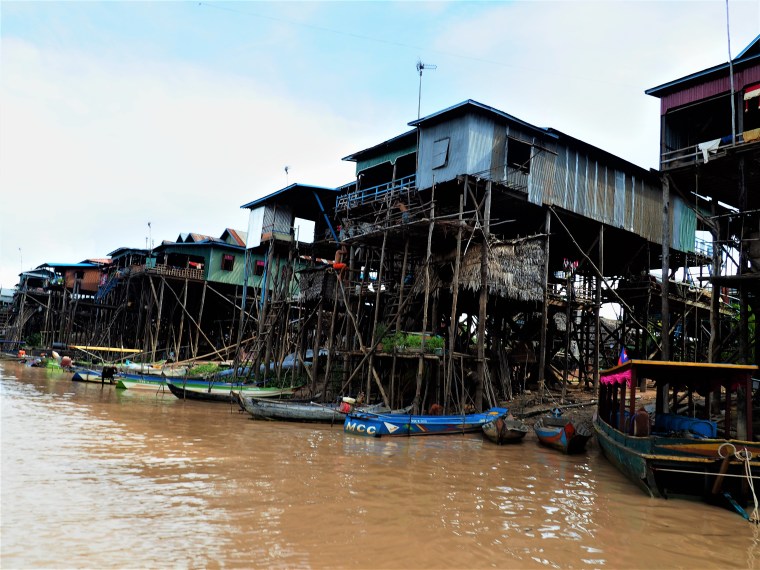
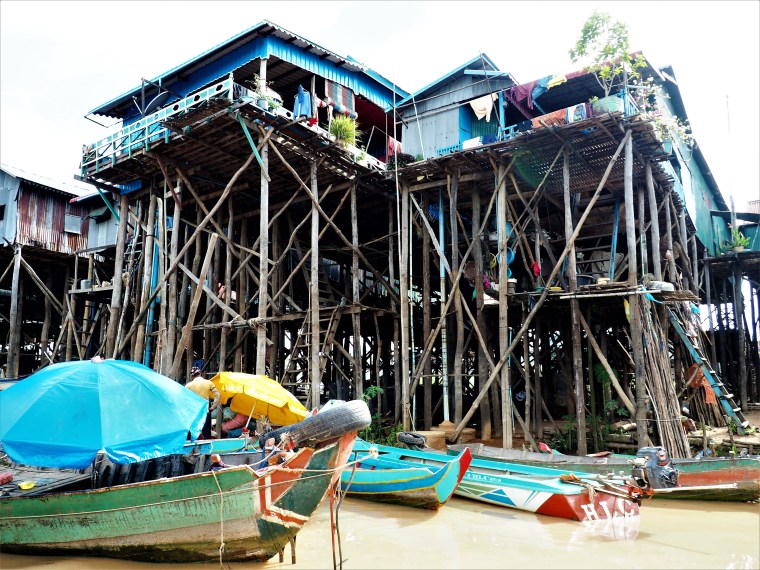


Away from the village and farther down the river are mangroves where you can take a smaller boat into. I remembered Cambodia has snakes and decided to stick with the larger boat. When I stepped onto a another larger boat where a woman was selling mango and pineapples, there were two large cages in the water. One held alligators. The other held a massively long snake that made me glad I didn’t go into the mangroves.

On this tour, I met a Mongolian woman who lives in Australia who is married to a Romanian. She works for an IT company. Her company asked her to move to Australia and she lives happily there. She was very chatty, well-traveled, and continues to visit her family in Ulaanbaatar.
BACK TO MONGOLIA
I took the bus back to Phnom Penh. My flight back to Seoul didn’t leave Cambodia until midnight. I had to check out of my room at noon and spent the whole day and evening wandering around the city. I walked around the Royal Palace to a street with boutiques and the British embassy. The roads by the Royal Palace were closed off to cars making it the only quiet area and no one yelling, “Lady, tuk tuk?” I spent an hour in the National Museum of Cambodia. A small museum with just one floor and a garden in the middle where monks sat under the trees by the ponds. In the evening, I got a two-hour Swedish massage. Heavenly! When it was 21:00, a tuk tuk took me back to the airport.
Due to the two hour time difference, I landed in Seoul at 7 where I had another seven-hours to kill. Exhausted, I fell asleep in the terminal to Astana, Kazakhstan. The flight back to Ulaanbaatar is three-hours from Seoul.
I’m proud of myself for going on this trip on my own. There are trade-offs when traveling by yourself.
Some positive points are:
- You will always meet other people. Southeast Asia has a lot of solo travelers and hostels are fun places to meet people.
- You can do whatever you want without asking someone else what they want.
- You step outside of your comfort zone.
- It’s liberating and exciting!
But the negative points are:
- There’s no one to rally you when you’re tired.
- No one to double check with. You’ve got to make sure you’ve packed everything and have your passport on your own.
- You must deal with and solve your own problems which can also be a positive factor.
The positive points outweigh the negative.
